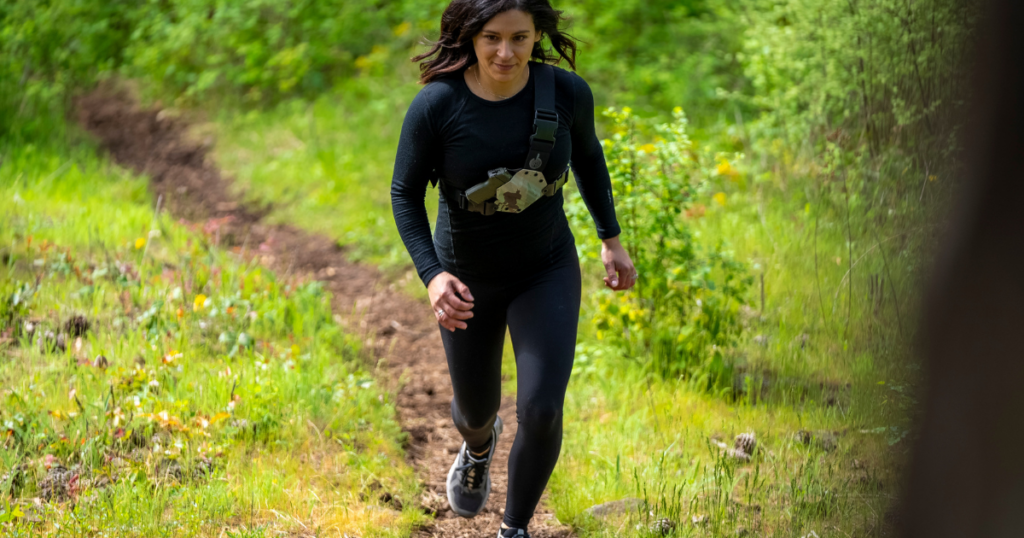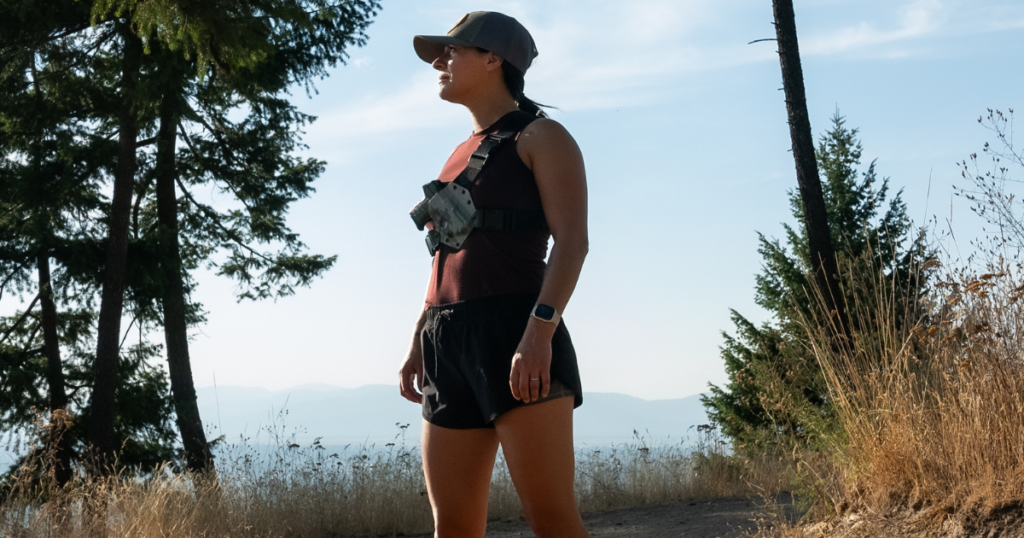Running is an excellent way to stay fit and enjoy the outdoors, but it can also present safety concerns – whether it’s an encounter with wildlife or the risk of crossing paths with aggressive individuals. For many, the solution is to carry a firearm while running so they’re prepared for any situation. However, choosing the right holster for running is essential to maintaining both comfort and security.
Let’s explore what to consider when selecting a running holster and the different types available.
Key Considerations When Choosing a Holster for Running
Selecting the right gun holster for running is important to ensure safety, comfort, and functionality. With numerous options available, understanding these factors will help you make a decision that aligns with your needs and lifestyle.
Comfort and Fit
A running holster should have a secure, non-chafing fit that allows for extended wear without irritation. For example, our Kenai Chest Holster offers a snug fit that distributes weight evenly, reducing strain and boosting overall comfort.
Look for designs that contour to your body and are made from lightweight, breathable materials (such as neoprene or padded nylon). These materials help minimize discomfort and prevent chafing during long runs.
Retention and Security
A reliable holster must also securely hold your firearm in place – especially during high-impact activities like running.
There are various retention levels, with Level 1 being the most common for activewear. Level 1 relies on friction or passive mechanisms to secure your firearm. Some holsters may use Level 2 or Level 3 systems, which incorporate additional features (like thumb breaks, straps, or locking mechanisms) for added security, but these will slow down your draw.
At GunfightersINC, all our holsters are designed with Level 1 Passive Retention that uses friction for a secure hold. This system eliminates the need for screws, straps, or mechanisms that could fail or slow you down.
Accessibility
In an emergency, quick access to your firearm is critical. And holster positioning significantly impacts accessibility.
The best position for holstering a gun while running depends on personal preference and body type, but common positions include the waist, chest, and ankle.
Waist holsters offer convenience but can be restrictive during movement. Chest holsters allow rapid access without hindering your stride. Ankle holsters provide discretion but will slow down your draw time.
Choose a positioning option that suits your running style and provides rapid response when needed.
Durability
Running exposes holsters to various environmental elements, so durability is key. Opt for holsters constructed from materials that withstand the rigors of the outdoors and resist sweat and moisture.
Our Kenai Chest Holster is an excellent example of a holster designed with durability in mind. Constructed from rugged materials like high-strength polymer and waterproof nylon, the Kenai is built to withstand the harshest environments and regular exposure to sweat and moisture.
Types of Gun Holsters for Running
Let’s examine several types of holsters suitable for running.
Waistband Holsters
Waistband holsters are popular for their accessibility and ease of use. They fit snugly around the waist and allow quick firearm access.
However, waistband holsters can feel constricting during intense activities, as they rely on a belt or similar platform for attachment, which may not be ideal for all body types.
They work best with loose-fitting clothing that conceals the holster without adding bulk. While effective for some runners, those with slimmer builds or who prefer lightweight attire might find waistband holsters awkward.
Chest Holsters

Chest holsters, like our Kenai Chest Holster, offer distinct advantages for runners. Positioned across the torso, they provide easy access without blocking movement. This makes them ideal for trail runners or those who prefer a balanced weight distribution.
Compared to other options, chest holsters minimize bouncing and chafing and offer a secure fit that boosts comfort over long distances. They’re particularly beneficial for those who need to carry larger firearms or additional gear.
Read Why You Should Consider a Chest Holster for a deeper dive into these holsters.
Belly Band Holsters
Belly band holsters are known for their flexibility and comfort, accommodating many body types. Made from stretchy, breathable materials, they wrap around the torso and can be worn high or low, depending on your preference.
Their versatility allows them to integrate with various running outfits, making them a great option for runners who prioritize comfort and adaptability.
However, they may require frequent adjustments to keep your firearm in place during intense activities. And some can find them restrictive while running.
Ankle Holsters
Ankle holsters offer a discreet carrying option, but they have limitations for runners. While they provide security and concealment, accessing an ankle holster is challenging when moving.
Consider using ankle holsters in environments where immediate access is unlikely, or pair them with another holster type for versatility.
Specialty Running Holsters
Though not technically holsters, off-body carry options specifically designed for running are available, like the Marathon Gun Pack.
These off-body carry options typically feature lightweight designs and moisture-wicking materials to increase comfort and usability. They often incorporate additional pockets for carrying items like keys or energy gels, making them a practical choice for long-distance runners who need to balance safety with convenience.
Tips for Selecting the Right Holster

Here’s how to pick a running holster that best suits your preferences.
Assess Your Needs
The first step in selecting a holster is assessing your requirements. First, consider the size of your firearm since larger guns may require more robust holster designs.
Second, look at your your running style. Whether you favor speed, endurance, or trail running can influence the type of holster that best supports your activities.
Additionally, consider your typical running attire. Tighter clothing may require more discreet options, while looser outfits will accommodate bulkier designs.
Trying out different holster types is crucial to finding the best fit. Consider experimenting with waist, chest, and ankle holsters to see which suits your comfort and accessibility needs.
Testing and Adjusting Your Holster
Once you’ve selected a potential holster, you’ll need to test it during your runs. Pay attention to how it feels over different distances and terrains. A holster should offer a secure fit without compromising movement or causing discomfort.
Adjusting the fit and position of your holster can make a significant difference. Straps should be tailored to your body’s contours to prevent slipping or bouncing. Regularly testing these adjustments will help you boost performance and safety during your runs.
FAQs About Running with a Gun Holster
What is the best gun to carry while running?
The best gun to carry while running is typically a compact or subcompact firearm, which is easier to conceal and lighter to carry.
Guns like the Glock 43, Sig Sauer P365, or Smith & Wesson M&P Shield are popular choices for runners due to their manageable size and weight.
It’s important to balance firearm size with comfort and accessibility so your gun doesn’t interfere with your running form or cause discomfort.
What running holster is best for people who don’t wear belts?
For those who don’t wear belts while running, options like belly band holsters, chest holsters, or ankle holsters are great alternatives.
How do runners conceal carry?
Runners can conceal carry by choosing holsters designed for active use, such as waist, belly band, or chest holsters. These holsters typically sit snugly against the body to prevent movement and offer comfort and discretion.
Runners should also consider clothing that complements the holster’s design – looser outfits may accommodate bulkier holsters, while more form-fitting clothes require slimmer, lower-profile holsters.
Stay Safe and Prepared on Every Run

Whether you opt for a chest holster like our Kenai Chest Holster or another design, the key is to use a holster that supports your activities without hindering your performance.
Stay prepared, stay safe, and explore GunfightersINC’s holster options to make your next run as secure as it is enjoyable.
